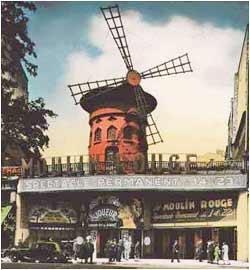

The Moulin Rouge first opened its doors in October, 1889 and still exists today. It soon became a well known rendez-vous for the rich and high class as well as bohemian artists and writers. It was well known as a place for the upper class to mingle with the "underworld" of society. The Moulin Rouge's illuminated windmill became a famous landmark in Paris. The Moulin Rouge was a combined dance hall and cabaret, and masked balls were featured on Saturdays and Wednesdays. It had a large dance floor with mirrored walls and a beautifully lit gallery inside and a stage outside with a large wooden elephant. Brassy music accompanied the risqu� dances of the can-can dancers. The club's most famous dancers were Jane Avril and La Goulue.Montmartre (translation: Mount of Martyrs, thought to refer to St. Denis, the first bishop of Paris, and possible martyrs that are buried on the hill) was once a suburb of Paris but is now just a part of the city. From before the revolution, this area was famous for it's wild, unrefined, and dangerous taverns. In 1881, the famous basilica Notre-Dame du Sacr�-Coeur was built in hopes that it would bring more organization and morality to this area. However, the presence of this great cathedral did not eliminate the wild life of nightclubs, dance halls, and caf�s in the area. The wild reputation of Martmartre lived on. Perhaps such an atmosphere could not have been eliminated by a single structure, because at this period of time, France was in a period of transition. Social barriers collapsed and artistic creativity flourished, and people were looking ahead to much more fun times.
The phrase "Vache enrag�e" ("enraged cow") as seen in this poster had become slang for rebellious bohemianism, the idiomatic expression for the hardship and struggles experienced by young artists.
Montmartre was the home to many important artists of the time. One of its most famous residents was Toulouse-Lautrec. Toulouse Lautrec is now one of the most famous nineteenth century French artists. He often spent whole nights at the Moulin Rouge, drinking and sketching the music-hall stars and members of royalty who wandered in. He frequently felt isolated from society because of a deformity. He surrounded himself with actresses, clowns, dancers, and prostitutes who became the subjects of his paintings. (All of the paintings on this page are by Toulouse- Lautrec.)